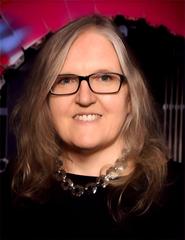URL: https://www.desy.de/news/news_search/index_eng.html
Breadcrumb Navigation
DESY News: Detector expert Ingrid Gregor becomes new Lead Scientist
News
News from the DESY research centre
Detector expert Ingrid Gregor becomes new Lead Scientist
Ingrid Gregor, DESY particle physicist and professor at the University of Bonn, has been made Lead Scientist at DESY. Gregor, an expert for silicon detectors, works on the ATLAS experiment, one of the large international detectors at the Large Hadron Collider LHC at CERN near Geneva. She is in charge of the construction of central new components for the upgrade of the ATLAS detector, which are assembled at DESY. She also heads the ATLAS group at DESY.
When protons collide in the accelerator and the particle detectors are running at full power to record all the interesting collisions with as much detail as possible, Ingrid Gregor is in her element. The DESY researcher, who previously worked on DESY's own HERMES and ZEUS experiments, has been a scientist at the gigantic ATLAS experiment at CERN in Geneva since the start of the LHC. ATLAS was one of the experiments to discover the Higgs particle ten years ago, the last missing piece of the puzzle in the world of tiny particles which helps researchers draw conclusions about the rules of our universe. As a specialist in silicon detectors, Gregor is responsible for the inner layers of the giant, the area close to the collision point, where the particle density is enormously high and poses great challenges on the technology.
Silicon detectors, which are often used in particle physics, are particularly suitable for these challenges. They have a high resolution, meaning they can collect a lot of detail about the particles flying through; they are fast and efficient and take up little space in the detector because sensors and readout are already connected, creating as little "dead space" as possible in which potentially interesting processes could be lost. Ingrid Gregor has specialised in this type of detector and also ensures that the technology is constantly developing.
She needs this expertise for the major challenge now facing the CMS and ATLAS groups at DESY: by 2029, when the Large Hadron Collider is supposed to start up again after the next shutdown with much more collisions than are possible today, the detectors must also be made fit for this new challenge. DESY has committed to build the end caps of the silicon tracker for the upgrade of both the CMS and the ATLAS detectors. A brand new lab space called Detector Assembly Facility DAF has been set up on campus and assembly of the end caps will start here soon.
"In about four and a half years, the end caps are supposed to be done and off the yard to be installed in the experiments. It's a busy time here at the DAF, and has been for months," Gregor explains. In one part of the DAF, several hundred high-precision silicon detectors are being developed, built and tested in the clean room. In another part, they are then assembled, partly with robots, onto carbon fibre structures and assembled into the approximately two-metre-high end caps of the silicon track detectors. Around 30 square metres of silicon detector surface are then ready for the deluge of particles from the LHC.
At the same time, Ingrid Gregor is also pushing technology frontiers with research on the versatile sensors. In a joint project financed by the Helmholtz Innovation Pool with other Helmholtz centres such as the KIT in Karlsruhe or the GSI in Darmstadt, pixel detectors with 65-nanometre technology are being further developed. They are more energy-efficient and thus cheaper and can be installed over a larger area. They are also very thin and extremely precise. With these properties, they are very interesting for applications outside particle physics as well. At DESY, they will first be installed in the test beam telescopes, which are used to put many detector prototypes through their paces in the particle beam.
"Ingrid has more than earned this recognition," says a delighted Beate Heinemann, DESY Research Director for the Particle Physics. "She is an outstanding scientist with proven expertise in the development of new technologies for detectors and in their construction. In addition, she is also an outstanding leader who seems to effortlessly succeed in inspiring and guiding people from a wide range of disciplines to achieve the goals she has set. For us as a major research institution, Ingrid and her many talents are invaluable!"




